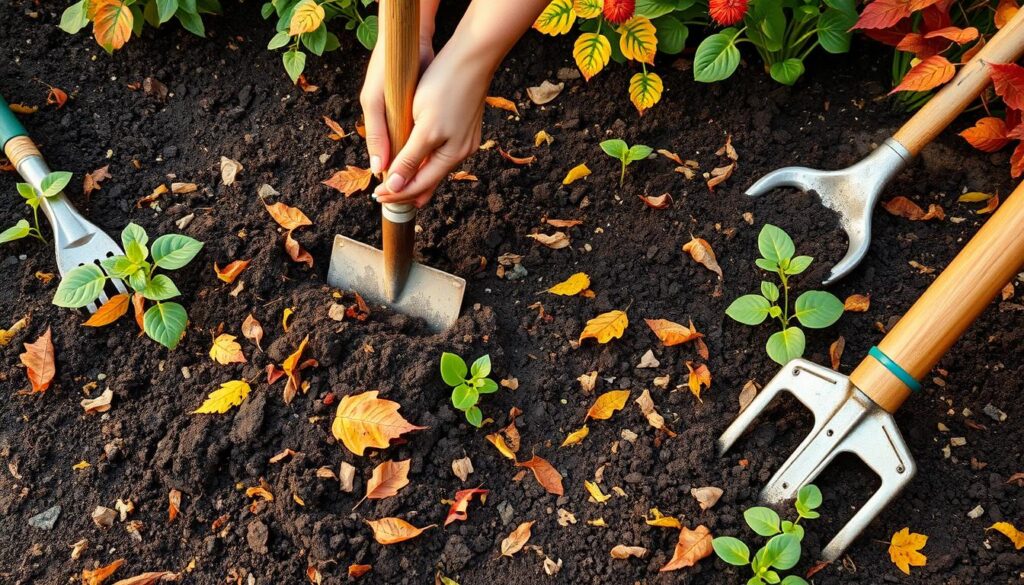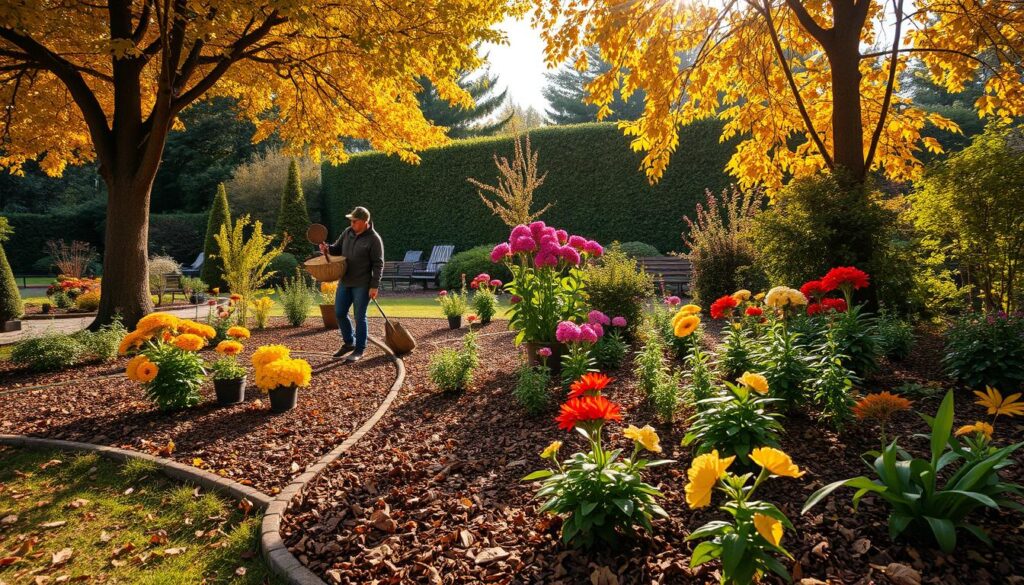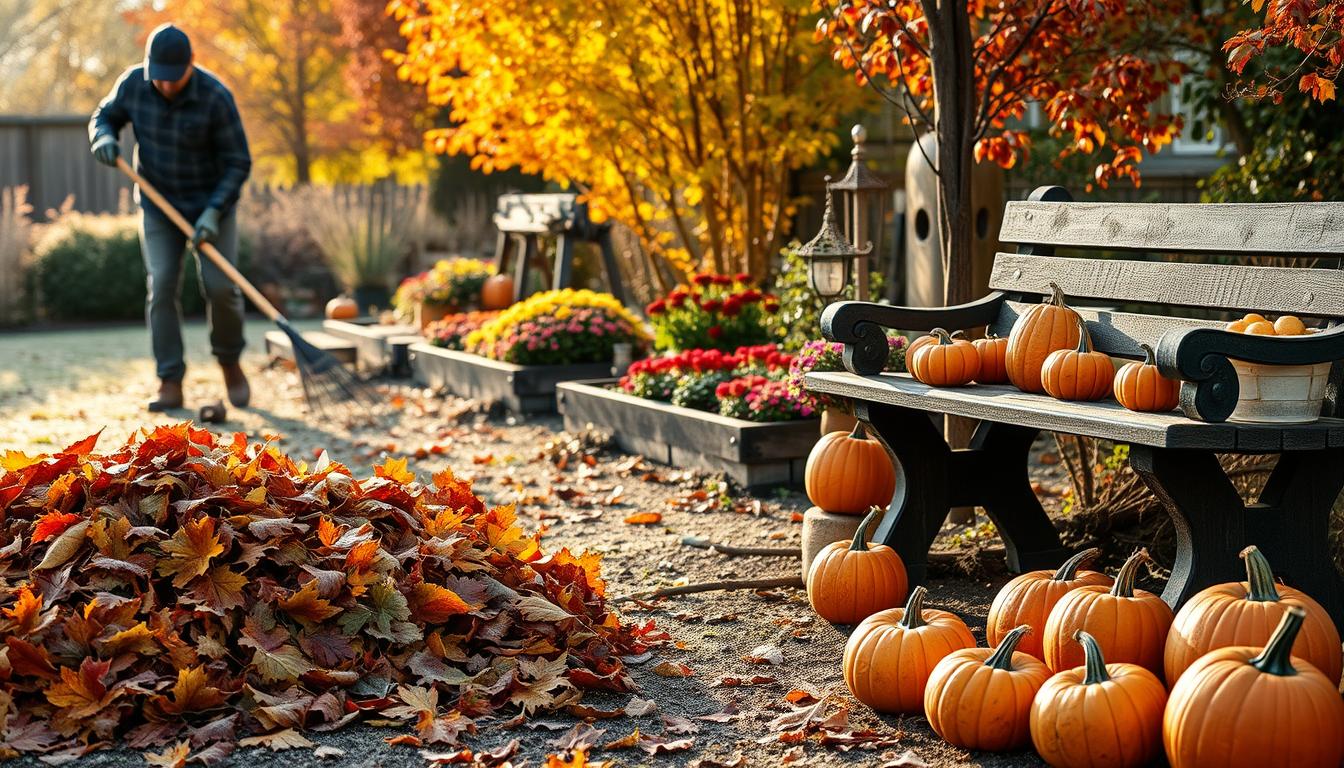Summer is ending, and it’s time to get your garden ready for fall. In the Kansas City Northland, the shift from summer’s warmth to fall’s cool brings new gardening chances and challenges. By taking a few key steps, you can keep your garden looking great through the fall and into the next season.
Key Takeaways
- Evaluate and remove summer plants to make way for fall and winter crops
- Prune perennials and shrubs to encourage healthy growth in the new season
- Prepare your soil by adding compost and other amendments to enrich the earth
- Plant fall and winter vegetables, focusing on cool-weather crops
- Mulch and protect your garden to insulate plants and retain moisture
- Plan for spring by planting bulbs and taking care of your garden tools
- Maintain a consistent gardening routine to ensure a successful fall and winter season
Introduction
As summer ends, it’s time to get your garden ready for the cooler months. Autumn gardening is key for tasks that help your plants do well through the seasons. This guide will show you how to prepare your garden for the change.
First, remove leaves and debris from your garden and lawn. This keeps your space clean and stops pests and diseases from spreading. Compost the organic matter to use as a soil amendment later.
Next, check and prune your perennials and shrubs. This gets them ready for sleep and ensures they grow well in spring. Don’t forget to clean and sharpen your gardening tools for the season ahead.
Preparing your soil for the cold months is also important. Add soil amendments to make it richer and better structured. This helps your plants grow well when you plant cool-season crops in fall and winter.
Doing these garden cleanup tasks now sets you up for a great autumn gardening season. Keep an eye out for more tips on lawn care and getting your garden ready for spring.
Evaluate and Remove Summer Plants
As days get shorter and temperatures drop, summer plants start to fade. It’s time to check which annuals are done and need to go. Petunias, marigolds, and other summer annuals will likely need to be removed. Also, get rid of any spent foliage and dead plants.
Removing these plants helps with pest control and disease prevention. Dead plants can become homes for pests and can spread diseases. By cleaning up your garden, you make room for a healthy fall and winter garden.
- Assess which annuals, such as petunias and marigolds, have finished their blooming cycle
- Remove any spent foliage and dead plants to prevent pests and diseases
- Prepare the garden beds for new fall-friendly plantings
With a little effort now, your garden will be ready for the seasons to come. Keep up with removing summer plants for a garden that’s easy to maintain and looks great.
Prune Perennials and Shrubs
As the seasons change, it’s key to give your garden some extra love. Fall is a great time to tidy up perennials and shrubs, getting them ready for a healthy spring. Pruning is vital for boosting your plants’ growth and looks, and it helps prevent diseases.
Key Considerations
When pruning, be careful and thoughtful with each plant. Some perennials, like hydrangeas and roses, need special fall care for their spring blooms. But cutting back some perennials might cut off potential blooms.
To keep your plants healthy and prevent diseases, cut out any dead or diseased branches. This helps the plant focus on growing strong, not weak parts. Remember, some plants just need a light trim, while others might need a bigger cut.
- Prune perennials and shrubs to help them grow well and bloom in spring
- Focus on hydrangeas and roses, which have special fall needs
- Remove dead or diseased branches to keep your plants healthy and prevent diseases
- Change your pruning based on what each plant needs
“Proper pruning can be the difference between a vibrant, thriving garden and one that struggles to reach its full potential.”
By carefully pruning your perennials and shrubs this fall, you’re preparing for a beautiful and healthy garden in spring.
Prepare Your Soil
Healthy soil is key for a great garden. Fall is the best time to get it ready for winter. Start by clearing out any plant debris and weeds from your garden beds. This stops diseases and pests from spreading and gets your soil ready for more work.
Then, add some compost or manure to your soil. These organic amendments will break down over winter, giving your plants the nutrients they need in the spring. In Kansas City Northland, using a cover crop like rye or clover can also stop soil erosion and make the soil richer.
- Remove plant debris and weeds from garden beds
- Add a layer of compost or well-rotted manure to enrich the soil
- Consider planting a winter cover crop to prevent erosion and add nutrients
By spending time to properly prepare your soil in the fall, you’re setting up your garden for success. These easy steps make sure your plants get the nutrients and support they need. They also prevent erosion and improve soil health.

Plant Fall and Winter Vegetables
As summer crops fade, it’s time to focus on fall and winter vegetables. These hardy plants do well in Kansas City Northland’s cool temperatures. They offer a great harvest into the colder months.
Cool-Weather Crops
Vegetables like kale, spinach, and Brussels sprouts are great for a longer growing season. You can plant them in late summer or early fall. They give you fresh produce long after summer crops end.
Adding fall crops and winter crops to your garden is smart. They let you enjoy cool-weather gardening and a longer growing season. These frost-tolerant vegetables are versatile in the kitchen. They also add color and texture to your autumn and winter garden.
| Vegetable | Planting Time | Harvest Time |
|---|---|---|
| Kale | Late Summer | Fall to Winter |
| Spinach | Early Fall | Fall to Winter |
| Brussels Sprouts | Late Summer | Fall to Winter |
Plan ahead and add these cool-weather crops to your garden. You’ll enjoy a bountiful harvest and a longer growing season in the Kansas City Northland.
Mulch and Protect
As summer ends and autumn’s cool breeze arrives, it’s time to focus on mulching and protecting your garden. This step boosts your garden’s look and helps your plants stay healthy and strong.
Using organic mulch like shredded leaves or straw brings many benefits. It keeps soil temperature steady, which is good for plant health and winter hardiness. It also keeps moisture in and stops weeds from growing.
Think about what your garden needs when choosing mulch. Leaf mulch breaks down and adds nutrients to the soil. Straw mulch insulates plants, protecting them from frost and cold.
- Spread 2-4 inches of organic mulch around your plants, avoiding stems and crowns.
- Add more mulch as needed to keep it evenly spread.
- Use burlap or row covers on plants to protect them from frost.
With mulching and protection, your garden will do well from summer to winter. This prepares it for a great spring next year.

“A well-mulched garden is a happy garden, resilient against the whims of nature and ready to burst forth with renewed vigor in the seasons ahead.”
Plan for Spring
As you get your garden ready for fall, think ahead to spring. It’s a great time to pick new plants or update your garden design. Ordering tulips and daffodils early means you’re set to plant them when it’s right.
Spring planning is key for gardeners. Look over your garden and see where it needs a boost. Think about adding new plants or changing the layout for a better look. This careful planning will make your spring garden beautiful and full of life.
Getting ready for spring means focusing on bulb planting. Ordering bulbs early helps you get the best selection and timely delivery. Tulips and daffodils should be planted in the fall for a beautiful start to the season. Think about which plants and where they’ll go for the best look and timing.
Planning for spring now means a smooth move from fall to the next season. With a good plan, you can enjoy a colorful and rewarding seasonal gardening experience.
Maintain Garden Tools
As the gardening season ends, it’s a great time to look after your garden tools. Taking good care of your tools not only makes them last longer but also makes sure they’re ready for next spring. We’ll cover the key steps for keeping your tools in great condition, from storage to sharpening and rust prevention.
Tool Storage and Rust Prevention
Storing your tools right is key to avoiding rust and damage. Clean your tools well after a busy season. Use a damp cloth to remove dirt, debris, or sap, and dry them completely. Keep your tools in a dry place, like a shed or garage, to protect them from the weather. Applying a thin layer of oil on metal parts can also help prevent rust.
Sharpening and Maintenance
Having sharp tools makes gardening easier and faster. Before storing, sharpen your pruners, loppers, and other blades. Use a sharpening stone or file as the guide suggests. For tools with moving parts, like wheelbarrows or loppers, a bit of oil will keep them running smoothly.
Spending a bit of time on tool care means your garden gear will be ready for the next season. With clean, sharp, and well-kept tools, you’ll find spring gardening tasks a breeze.
| Tool Maintenance Task | Frequency |
|---|---|
| Clean and dry tools | After each use |
| Sharpen blades | Once or twice per year |
| Apply light oil to moving parts | Annually |
| Store tools in a dry, sheltered location | During the off-season |
Preparing Your Garden for Fall: Essential Tasks to Tackle Now
As autumn’s cool air arrives, it’s time to switch your gardening focus. Move from summer’s bright flowers to getting your garden ready for the cold months. By doing a few key tasks now, your garden will do well in fall and be ready for spring.
First, evaluate and remove any lingering summer plants. This makes your garden look neat and prepares it for fall and winter plants. Check on perennials and cut back dead or damaged parts to help them grow better next year.
Next, nourish your soil. Add organic stuff like compost to make the soil richer and better for your plants. This helps your fall plants grow strong.
- Think about planting cool-weather crops like kale, spinach, and Brussels sprouts to keep gardening going.
- Put mulch around your plants to keep their roots warm and hold in moisture.
- Use burlap or straw to cover tender plants from frost.
Getting your garden ready for winter means planning for spring. Think about where new bulbs and perennials will go. Make a list of areas needing pruning or dividing.
Finally, clean and store your garden tools for winter. This keeps them ready for your next gardening project.
By following these steps, you can smoothly move your garden from summer to fall. Your garden will stay healthy and ready for winter. These tips are great for gardeners in Kansas City Northland and beyond. They help your garden look great in autumn and prepare it for a lively spring. Happy gardening!
Conclusion
As the seasons change, getting your garden ready for fall is key to its health and life. This guide has shown you how to make your garden succeed during the cooler months and into spring. Tasks like removing summer plants, pruning, preparing the soil, and planting for fall and winter are crucial.
Don’t forget to mulch and protect your plants. Also, plan for spring and keep your garden tools in good shape. With a bit of effort now, you’ll enjoy your autumn garden preparation and the gardening tasks needed for garden maintenance and plant care during winterizing garden and into spring.
By adopting these fall gardening practices, you’re on your way to a healthy, lively, and fruitful garden. It will keep thriving and bring you joy for many years.
FAQ
What are the essential tasks to prepare my garden for fall?
To get your garden ready for fall, start by checking and removing summer plants. Then, prune perennials and shrubs. Make sure to prepare the soil, plant fall and winter veggies, and add mulch and protection.
Don’t forget to plan for spring and keep your garden tools in good shape.
When is the best time to prune perennials and shrubs in the Kansas City Northland area?
In the Kansas City Northland, pay extra attention to shrubs like hydrangeas and roses. They need special care in fall. Remember, some plants need a light trim, while others should wait until spring to avoid missing blooms.
What are some good cool-weather crops to plant in the fall in the Kansas City Northland?
For the Kansas City Northland, plant cool-weather crops like kale, spinach, and Brussels sprouts in late summer or early fall. These hardy veggies will keep producing into the cold months, offering fresh food well into winter.
How can I prepare my garden soil for the fall and winter seasons?
Start by clearing your garden beds of any leftover plant debris and weeds. Then, add compost or well-rotted manure to enrich the soil. Using a winter cover crop like rye or clover can also help prevent soil erosion and add nutrients.
When should I start planning for my spring garden?
After finishing your fall gardening, it’s a great time to plan for spring. Think about which plants you want to add or replace and draw up new garden designs. Ordering bulbs for spring flowers like tulips and daffodils now will get you ready for planting season.
How should I maintain my garden tools for the fall and winter?
Clean and sharpen your tools as you wrap up your gardening for the season. Keeping them in good condition means they’ll be ready to go when spring arrives. Store them in a dry, protected spot to prevent rust and damage.






